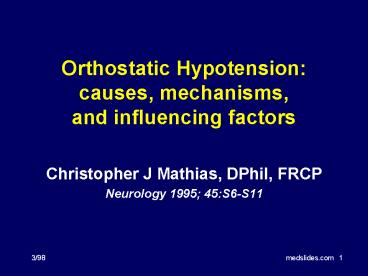Orthostatic Hypotension: causes, mechanisms, and influencing factors - PowerPoint PPT Presentation
1 / 24
Title:
Orthostatic Hypotension: causes, mechanisms, and influencing factors
Description:
... a head-up tilt table test at an angle of at least 60 degrees ... time of day (morning on rising) warm environment (hot weather, central heating, hot bath) ... – PowerPoint PPT presentation
Number of Views:4180
Avg rating:3.0/5.0
Title: Orthostatic Hypotension: causes, mechanisms, and influencing factors
1
Orthostatic Hypotensioncauses, mechanisms, and
influencing factors
- Christopher J Mathias, DPhil, FRCP
- Neurology 1995 45S6-S11
2
Control of Blood Pressure
- autonomic nervous system
- hearts resistance and capacitance
- intravascular volume
- hormones
- renin-angiotensin-aldosterone system
- aldosterone
- local endothelin or nitric acid
Neurology 1995 45S6-S11
3
Orthostatic hypotensionconsensus definition (1)
- reduction of
- systolic BP of at least 20 mm Hg, or
- diastolic BP of at least 10 mm Hg
- within 3 minutes of standing (some may
- take more than 10 minutes)
- similar drop in blood pressure within 3 minutes
in a head-up tilt table test at an angle of at
least 60 degrees
1. Neurology 1996 461470
4
Orthostatic hypotension
- when associated with relevant symptoms
indicating impaired perfusion, a smaller drop in
blood pressure may be equally important,
especially for further investigation.
Neurology 1995 45S6-S11
5
Orthostatic hypotensionsymptoms
- symptoms develop on assuming the erect posture
- lightheadedness, dizziness, blurred vision,
weakness, fatigue, cognitive impairment, nausea,
palpitations, tremulousness, headache, neck ache - some patients may be asymptomatic
Neurology 1996 461470
6
Autonomic Nervous SystemNeurogenic causes of
orthostatic hypotension
- Primary autonomic failure
- Secondary autonomic failure
Neurology 1995 45S6-S11
7
Primary autonomic failure
- chronic
- pure autonomic failure
- Shy-Drager syndrome
- with parkinsonian features
- with cerebellar and pyramidal features
- with multiple system atrophy (combination)
- acute or subacute dysautonomias
Neurology 1995 45S6-S11
8
Secondary autonomic failure
- central
- spinal
- peripheral
- miscellaneous
- drugs
- neurally mediated syncope
Neurology 1995 45S6-S11
9
Secondary autonomic failure1. central
- brain tumors, especially of the 3rd ventricle or
posterior fossa - multiple sclerosis
- syringobulbia
- age-related
Neurology 1995 45S6-S11
10
Secondary autonomic failure2. spinal
- spinal transverse myelitis
- transverse myelitis
- syringomyelia
- spinal tumor
Neurology 1995 45S6-S11
11
Secondary autonomic failure3. peripheral
- afferent
- Guillain-Barre syndrome, Tabes dorsalis,
Holmes-Adie syndrome - efferent
- diabetes mellitus, amyloidsis, surgery,
dopamine-b-hydroxylase deficiency - afferent / efferent
- familial dysautonomia (Riley-Day synd)
Neurology 1995 45S6-S11
12
Secondary autonomic failure4. miscellaneous
- autoimmune and collagen disorders
- renal failure
- neoplasia
- human immunodeficiency virus infection
Neurology 1995 45S6-S11
13
Secondary autonomic failure5. drugs
- centrally acting
- clonidine, methyldopa, reserpine, barbiturates,
anesthetics - peripherally acting
- guanethidine, bethanadine
- phenoxybenzamine, prazosin
- propranolol, timolol
Neurology 1995 45S6-S11
14
Secondary autonomic failure6. neurally mediated
syncope
- vasovagal syncope
- carotid sinus hypersensitivity
- micturition syncope
- glossopharyngeal neuralgia and syncope
Neurology 1995 45S6-S11
15
Neurogenic orthostatic hypotensionpathophysiology
- major abnormality is the lack of neurally
mediated vasoconstriction in large vascular beds
(skeletal muscle and the splanchnic bed) - gravitational pooling in the periphery with lack
of compensatory change
Neurology 1995 45S6-S11
16
Plasma norepinephrine level
- measure of sympathetic activity
- in neurogenic OH, the sympathetic nervous system
is not activated, the rise in NE level is minimal
or absent despite a marked fall in BP - basal NE level cannot determine the site of lesion
Neurology 1995 45S6-S11
17
Rise in plasma norepinephrine after 10 min
Head-up tilt to 450
Multiple system atrophy
Noradrenaline (pg/mL)
Pure autonomic failure
Dopamine ß-OHdeficiency
18
Nonneurogenic causesof hypotension
- cardiac impairment
- myocardial impaired ventricular filling
- impaired output cardiac arrhythmia
- vasodilatation
- low intravascular volume
- blood / plasma loss fluid / electrolytes
- miscellaneous
Neurology 1995 45S6-S11
19
Nonneurogenic Hypotension1. cardiac impairment
- myocardial
- myocarditis, myocardial infarction
- impaired ventricular filling
- atrial myxoma, constrictive pericarditis
- impaired output
- aortic stenosis, hypertrophic cardiomyopathy
- cardiac arrhythmia
- bradycardia, tachydysrhythmias
Neurology 1995 45S6-S11
20
Nonneurogenic Hypotension2. vasodilatation
- drugs-nitrates
- alcohol
- heat, pyrexia
- hyperbradykinism
- systemic mastocytosis
- extensive varicose veins
Neurology 1995 45S6-S11
21
Nonneurogenic Hypotension3. low intravascular
volume
- Blood / plasma loss
- hemorrhage, burns, hemodialysis
- Fluid / electrolyte
- inadequate intake (anorexia, vomiting)
- diarrhea (including ileostomy)
- renal/endocrine (salt losing nephropathy,
- Addisons, diabetes insipidus, diuretics
Neurology 1995 45S6-S11
22
Nonneurogenic Hypotension3. miscellaneous
- Sepsis
- Endotoxic shock
Neurology 1995 45S6-S11
23
Factors influencingpostural hypotension
- speed of positional change
- prolonged recumbency
- time of day (morning on rising)
- warm environment (hot weather, central heating,
hot bath)
Neurology 1995 45S6-S11
24
Factors influencingpostural hypotension
- food and alcohol (1)
- physical exertion (2)(bending forward, abdominal
compression, leg crossing, squatting) - increased intrathoracic pressure(micturition,
cough, defication)
1. Mathias CJ, et al. 1992 Autonomic Failure 2.
Smith GDP, et al. 1993 BHJ 1993 69359-361

